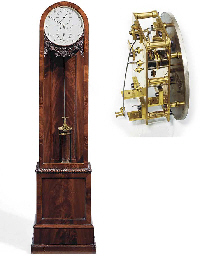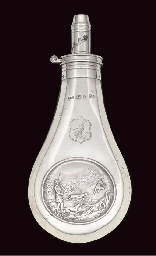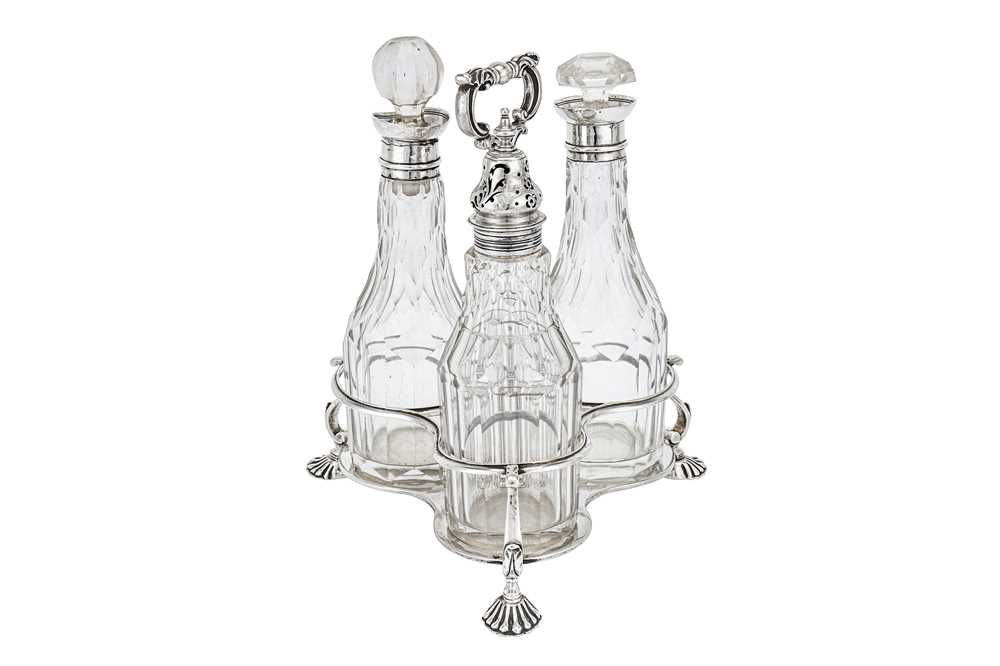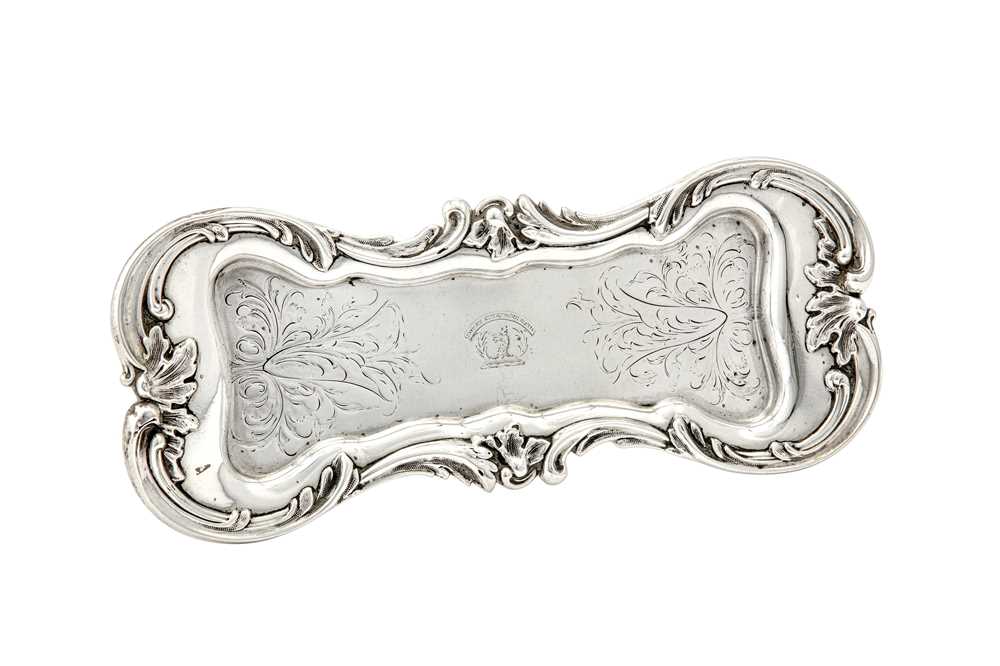An early Victorian weight-driven hook-and-spike wall clock housed in a rare contemporary oak floor standing 'longcase' Attributed to Whitehurst, Derby, circa 1840 The two train four pillar plated eight-day bell striking movement with anchor escapement regulated by standard fifteen-inch pendulum and stamped with serial number 6557 to backplate, the 10 inch circular white painted Roman numeral dial with gilt painted outer band, steel spade hands and now bearing signature signed WILLIS AND MAY abve feint inscription DERBY to centre, the movement previoulsy fitted with sheet metal dust covers, the rear with hanging hoop and spurs, 23cm (10ins) high; in a rare oak floor standing case, early 19th century, with ogee moulded triangular pediment above rectangular door with glazed 9 inch circular dial aperture within a square moulded surround to the fixed hood over shallow cavetto moulded throat and conforming triangular-top door flanked by canted angles to trunk, on plain plinth base with moulded skirt, 198cm (78ins) high, (2). John Whitehurst (I) was born in Congleton, Cheshire in 1713, he was apprenticed as a clockmaker to his father (of the same name) before setting up business in Derby in 1736 - the same year he installed a turret clock to the newly completed Guildhall. He was an accomplished maker and scientist who had a particular interest in geology. He moved to London in 1780 in order to take up position at the Royal Mint as 'Stamper of the Money Weights' as well as pursue his scientific interests. He was founder member of the Lunar Society and was elected to the Royal Society in 1783. He died in 1788 leaving the Derby clockmaking business to his nephew also called John (II) who in-turn took his son of the same name (John III) into partnership in 1809. The firm traded as 'Whitehurst & Son' until 1834 when the business reverted to just 'Whitehurst' on the death of John (II). The business continued under the Whitehurst name until the death of John (III) in 1855 when it was sold to Roskell of Liverpool who subsequently wound up operations in 1862. However a former employee, John Smith resurrected the business which is still trading today as 'Smith of Derby'. The current lot utilises a simple but ingenious form of single-arbor countwheel warned striking which, by using pins fitted to the greatwheel (rather than slots in a countwheel) to lock the striking removes the need for the provision of overlift. This, coupled with the efficient layout of the going train (incorporating half-seconds pendulum and chain pulley wind) exemplifies Whitehurst's approach to clockmaking which, in the case of the current lot, has resulted in a timepiece perfectly engineered for backstairs use. The rare oak floor-standing case included in the lot appears to have been specifically supplied to house this type of clock. The hood has been made with the provision to either suspend the movement from a hook applied to a panel fitted to the backboard or rest on a seatboard slid into grooves cut within the side uprights of the trunk (this 'seatboard option' appears never to have been used). The utilitarian appearance of the case is also entirely commensurate with the clock's backstairs use. Furthermore details such as the shallow triangular pediment echoed in the top of the trunk door are the reminiscent of those seen on other early 19th century longcase clocks by the Whitehurst family, from this it is perhaps appropriate to speculate that the case may have been supplied as an 'option' to house such clocks by the Whitehurst family. Condition report disclaimer
An early Victorian weight-driven hook-and-spike wall clock housed in a rare contemporary oak floor standing 'longcase' Attributed to Whitehurst, Derby, circa 1840 The two train four pillar plated eight-day bell striking movement with anchor escapement regulated by standard fifteen-inch pendulum and stamped with serial number 6557 to backplate, the 10 inch circular white painted Roman numeral dial with gilt painted outer band, steel spade hands and now bearing signature signed WILLIS AND MAY abve feint inscription DERBY to centre, the movement previoulsy fitted with sheet metal dust covers, the rear with hanging hoop and spurs, 23cm (10ins) high; in a rare oak floor standing case, early 19th century, with ogee moulded triangular pediment above rectangular door with glazed 9 inch circular dial aperture within a square moulded surround to the fixed hood over shallow cavetto moulded throat and conforming triangular-top door flanked by canted angles to trunk, on plain plinth base with moulded skirt, 198cm (78ins) high, (2). John Whitehurst (I) was born in Congleton, Cheshire in 1713, he was apprenticed as a clockmaker to his father (of the same name) before setting up business in Derby in 1736 - the same year he installed a turret clock to the newly completed Guildhall. He was an accomplished maker and scientist who had a particular interest in geology. He moved to London in 1780 in order to take up position at the Royal Mint as 'Stamper of the Money Weights' as well as pursue his scientific interests. He was founder member of the Lunar Society and was elected to the Royal Society in 1783. He died in 1788 leaving the Derby clockmaking business to his nephew also called John (II) who in-turn took his son of the same name (John III) into partnership in 1809. The firm traded as 'Whitehurst & Son' until 1834 when the business reverted to just 'Whitehurst' on the death of John (II). The business continued under the Whitehurst name until the death of John (III) in 1855 when it was sold to Roskell of Liverpool who subsequently wound up operations in 1862. However a former employee, John Smith resurrected the business which is still trading today as 'Smith of Derby'. The current lot utilises a simple but ingenious form of single-arbor countwheel warned striking which, by using pins fitted to the greatwheel (rather than slots in a countwheel) to lock the striking removes the need for the provision of overlift. This, coupled with the efficient layout of the going train (incorporating half-seconds pendulum and chain pulley wind) exemplifies Whitehurst's approach to clockmaking which, in the case of the current lot, has resulted in a timepiece perfectly engineered for backstairs use. The rare oak floor-standing case included in the lot appears to have been specifically supplied to house this type of clock. The hood has been made with the provision to either suspend the movement from a hook applied to a panel fitted to the backboard or rest on a seatboard slid into grooves cut within the side uprights of the trunk (this 'seatboard option' appears never to have been used). The utilitarian appearance of the case is also entirely commensurate with the clock's backstairs use. Furthermore details such as the shallow triangular pediment echoed in the top of the trunk door are the reminiscent of those seen on other early 19th century longcase clocks by the Whitehurst family, from this it is perhaps appropriate to speculate that the case may have been supplied as an 'option' to house such clocks by the Whitehurst family. Condition report disclaimer















Try LotSearch and its premium features for 7 days - without any costs!
Be notified automatically about new items in upcoming auctions.
Create an alert